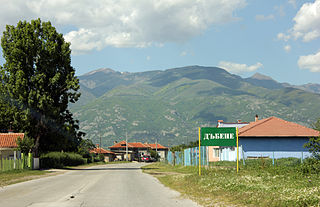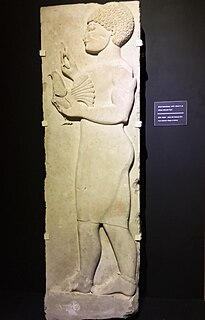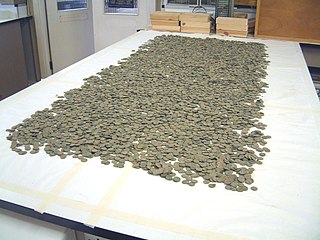 W
WThe Carlton-in-Lindrick knight is a small bronze figurine from the twelfth century, depicting a mounted knight armed for combat. It is an important find because period depictions of mounted European knights are relatively rare.
 W
WThe Dabene Treasure was unearthed in 2004 near the village of Dabene in the municipality of Karlovo, Plovdiv Province, central Bulgaria. The excavations were led by the archaeologist Martin Hristov. Other elements of the treasure were discovered in 2006.
 W
WThe Gökçeler relief is an Achaemenid-era tomb relief made in the Anatolian-Persian style. It was found in 2004 in the village of Gökçeler in Manisa Province of present-day Turkey. The area of discovery corresponds to the northern part of the historic region of Lydia, at a time when it was a satrapy (province) of the Achaemenid Persian Empire. The relief is made out of limestone and measures 1.79m × 0.55m × 0.25m. The relief is a "distinctive product of the artistic synthesis classified as Graeco-Persian or Anatolian-Persian". It was created between the late 6th century and early 5th century BC. It may be used as "yet further evidence for the presence of Persians in the region".
 W
WThe Huxley Hoard is a hoard of Viking jewellery from around 900-910 found buried near Huxley, Cheshire, England. It consists of 21 silver bracelets, one silver ingot, and 39 lead fragments, weighing around 1.5 kilograms (3.3 lb) in total. The bracelets might have been produced by Norse settlers in Dublin and possibly buried for safekeeping by Viking refugees settling in Cheshire and the Wirral in the early 900's. It was discovered by Steve Reynoldson in November 2004 after he found fragments of lead 30 centimetres (12 in) underground using a metal detector.
 W
WKhirbet el-Mastarah is an archaeological site that includes the largest of the complex oval compound type habitation sites located in the middle Jordan Valley in the West Bank.
 W
WThe SS Michigan was a passenger steamship which transported passengers across the Great Lakes. At the time of her construction, she was one of the most advanced steamships on the Great Lakes. She offered luxurious accommodations for customers that included heated cabins, ornate wood design, and oil paintings to decorate the rooms. She was then purchased by Milwaukee Railway Company. In February 1885, the Michigan became entrapped in an ice pack, and a few weeks later, sank in Lake Michigan.
 W
WThe term Pool of Siloam refers to a number of rock-cut pools on the southern slope of the Wadi Hilweh, considered by some archaeologists to be the original site of Jerusalem, located outside the walls of the Old City to the southeast. The pools were fed by the waters of the Gihon Spring, carried there by the Siloam Tunnel.
 W
WThe Salcombe Cannon wrecksite is close to two other designated wrecksites in the Erme Estuary which the South West Maritime Archaeological Group (SWMAG) was licensed to investigate. In 1992 this group described the Salcombe Cannon site as:"A cannon site with nothing else visible".
 W
WThe Sedgeford Torc is a broken Iron Age gold torc found near the village of Sedgeford in Norfolk. The main part of the torc was found during harrowing of a field in 1965, and the missing terminal was found by Dr. Steve Hammond during fieldwork by the Sedgeford Historical and Archaeological Research Project in 2004. The torc is now displayed at the British Museum.
 W
WThe Shorwell helmet is an Anglo-Saxon helmet from the early to mid-sixth century AD found near Shorwell on the Isle of Wight in southern England. It was one of the grave goods of a high-status Anglo-Saxon warrior, and was found with other objects such as a pattern-welded sword and hanging bowl. One of only six known Anglo-Saxon helmets, alongside those from Benty Grange, Sutton Hoo, Coppergate, Wollaston, and Staffordshire, it is the sole example to derive from the continental Frankish style rather than the contemporaneous Northern "crested helmets" used in England and Scandinavia.
 W
WTel Ro'im West is a prehistoric archaeological site in the eastern slopes of the Naftalie ridge, where it descends into the Hula Valley in northern Israel. The site offers a variety of resources including water, animals, and plants. It is surrounded by fertile soil to its south and east. In 2004, prior to road construction work, a salvage excavation took place. Two areas were excavated and within them, four settlement phases (strata) from the Pre-Pottery Neolithic and Pottery Neolithic periods were uncovered. The findings represent a northern-Levantine material culture, which implies this region has been a boundary between the material culture of the northern and southern Levant.
 W
WTell Ezou is a prehistoric, Neolithic tell, about 2 hectares (220,000 sq ft) in size, located between Krak des Chevaliers and Homs, in Syria.
 W
WThe Thornbury Hoard is a hoard of 11,460 copper alloy Roman coins, mainly radiates and nummi, dating from 260 to 348, found in the back garden of Ken Allen in Thornbury, South Gloucestershire, England while digging a pond in March 2004. It was described as the "third largest of its kind" found in Great Britain.